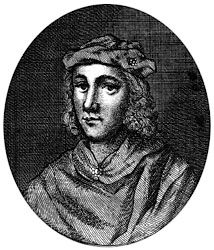
Constantine, son of Áed was an early King of Scotland, known then by the Gaelic name Alba. The Kingdom of Alba, a name which first appears in Constantine's lifetime, was situated in modern-day Scotland.

Kenneth MacAlpin or Kenneth I was King of Dál Riada (841–850), King of the Picts (843–858), and the King of Alba (843–858). He inherited the throne of Dál Riada from his father Alpín mac Echdach, founder of the Alpínid dynasty. Kenneth I conquered the kingdom of the Picts in 843–850 and began a campaign to seize all of Scotland and assimilate the Picts, for which he was posthumously nicknamed An Ferbasach. Forteviot became the capital of his kingdom, and he also fought the Britons of the Kingdom of Strathclyde and the invading Vikings from Scandinavia. Kenneth also relocated relics including the Stone of Scone from an abandoned abbey on Iona to his new domain.

The Picts were a group of peoples who lived in what is now northern and eastern Scotland during Late Antiquity and the Early Middle Ages. Where they lived and what their culture was like can be inferred from early medieval texts and Pictish stones. Their Latin name, Picti, appears in written records from the 3rd to the 10th century. Early medieval sources report the existence of a distinct Pictish language, which today is believed to have been an Insular Celtic language, closely related to the Brittonic spoken by the Britons who lived to the south.

Dál Riata or Dál Riada was a Gaelic kingdom that encompassed the western seaboard of Scotland and the north-eastern corner of Ireland, on each side of the North Channel. At its height in the 6th and 7th centuries, it covered what is now Argyll in Scotland and part of County Antrim in Northern Ireland. After a period of expansion, Dál Riata eventually became associated with the Gaelic Kingdom of Alba.
Óengus mac Fergusa was king of the Picts from 820 until 834. In Scottish historiography, he is associated with the veneration of Saint Andrew, the patron saint of Scotland.

Causantín or Constantín mac Fergusa was king of the Picts, in modern Scotland, from 789 until 820. He was until the Victorian era sometimes counted as Constantine I of Scotland; the title is now generally given to Causantín mac Cináeda. He is credited with having founded the church at Dunkeld which later received relics of St Columba from Iona.
Áed Find, or Áed mac Echdach, was king of Dál Riata. Áed was the son of Eochaid mac Echdach, a descendant of Domnall Brecc in the main line of Cenél nGabráin kings.
Fiannamail ua Dúnchado was a king of Dál Riata at the end of the 7th century. Little can be said with certainty other than the recording of his death in 700AD, where he is listed as having been slain alongside Flann mac Cind-fâelad of the Cianachta Glenn Geimin in present-day County Londonderry, Northern Ireland.
The House of Alpin, also known as the Alpínid dynasty, Clann Chináeda, and Clann Chinaeda meic Ailpín, was the kin-group which ruled in Pictland and then the kingdom of Alba from the advent of Kenneth MacAlpin in the 840s until the death of Malcolm II in 1034.

Óengus son of Fergus, was king of the Picts from 732 until his death in 761. His reign can be reconstructed in some detail from a variety of sources. The unprecedented gains he made, and the legacy he left, mean Óengus can be considered the first king of what would become Scotland.
Uuen (Wen) or Eogán in Gaelic was king of the Picts between 837–839.
Ciniod, Cináed or Cinadhon, son of Uuredech, was king of the Picts from 763 until 775.

The origins of the Kingdom of Alba pertain to the origins of the Kingdom of Alba, or the Gaelic Kingdom of Scotland, either as a mythological event or a historical process, during the Early Middle Ages.
Áed mac Boanta is believed to have been a king of Dál Riata.
Domnall mac Caustantín is thought to have been king of Dál Riata in the early ninth century.
Conall mac Áedáin was a king in Scotland in the years around 800. It is thought that he was a king, or sub-king, in Dál Riata.
Donncoirce was probably king of Dál Riata until his death in 792.

The House of Óengus is a proposed dynasty that may have ruled as Kings of the Picts, as well as overlords of the Kings of Dál Riata and possibly of all of northern Great Britain, for approximately a century from the 730s to the 830s AD. Their first ruler of Pictland was the great Óengus I of the Picts, who may be the figure carved into the St Andrews Sarcophagus pictured on the right.





